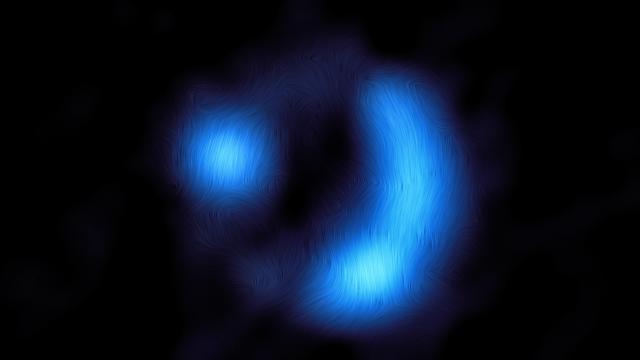A team of scientists looking at a faraway galaxy using the Atacama Large Millimeter/submillimeter Array (ALMA) have detected that galaxy’s magnetic field, making it the most distant galactic magnetic field yet detected.
It’s not known how early magnetic fields formed around galaxies, so the new finding importantly pushes back that timeline. The astronomers used ALMA to observe 9io9, a lensed galaxy at a redshift of z= 2.6. The galaxy’s light took 11 billion years to reach ALMA’s detectors in northern Chile.
To ALMA, the galaxy appears as it did when it was 2.5 billion years old. Its ancient magnetic fields could help astronomers understand how magnetic fields developed in other galaxies in the early universe.The researchers published their findings about the galaxy’s magnetic fields in Nature.
“Many people might not be aware that our entire galaxy and other galaxies are laced with magnetic fields, spanning tens of thousands of light-years,” said James Geach, an astrophysicist at the University of Hertfordshire and the study’s lead author, in a European Southern Observatory release. “This discovery gives us new clues as to how galactic-scale magnetic fields are formed.”
To find the magnetic field, the researchers looked at dust in 9io9. When a magnetic field is present, the grains of dust align themselves, and the light they emit is polarized. In 2021, a different team of researchers used a similar approach to look at the magnetic field surrounding the supermassive black hole at the centre of Messier 87.
The researchers’ ability to study 9io9 was improved because the galaxy is gravitationally lensed, meaning its light was magnified by a large structure between ALMA and the ancient galaxy. Using gravitational lensing to their advantage is also how astronomers spotted Earendel, the oldest known star, and some of the oldest known galaxies.
Magnetic fields near the centre of the Milky Way have also been detailed in the recent past, offering astronomers clues about how material surrounding the black hole at our own galaxy’s core may move around.
9io9’s magnetic field is fully formed, but still about 1000 times weaker than Earth’s field, according to the ESO release. But the galaxy’s field (as you may figure) is much larger, stretching across some 16,000 light-years. The researchers believe that the prodigious star formation in the early universe may have played a role in the hastened arrival of galactic-scale magnetic fields.
More observations may clarify the nature of 9io9’s magnetic field—how it originated and when—and observations of similarly ancient galaxies could improve scientists’ understanding of how widespread galactic magnetic fields were in the early universe.
